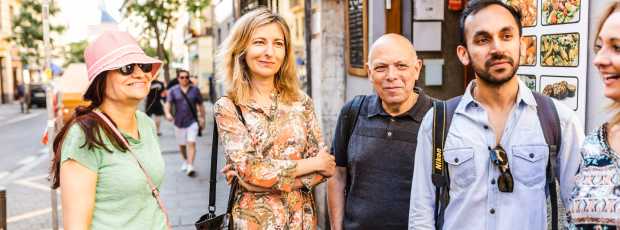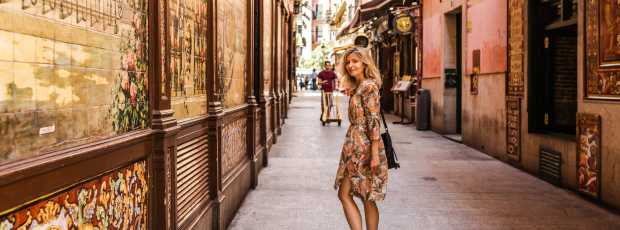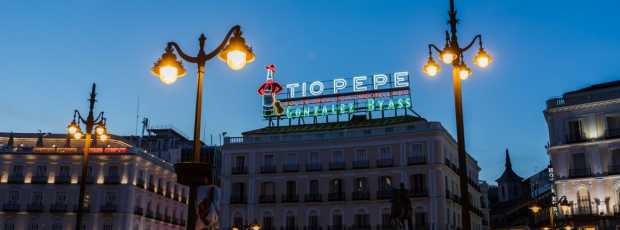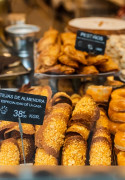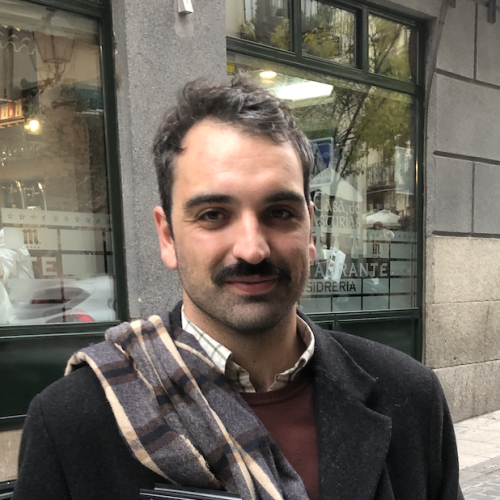Table Of Contents
- Where Should You Start Your Night in Madrid?
- Night Food Culture: Street Eats, Markets and Late Staples
- Bars, Pubs, and Social Hubs: By Type and Vibe
- Where Can You Hear Live Music in Madrid at Night?
- Where Are the Best Night Views in Madrid?
- Neighborhoods That Come Alive at Night
- Unique Local Night Traditions
- What Can You Do in Madrid at Night Without Drinking?
- Overrated Nightlife Picks: Keep, Tweak, or Skip
- How Do You Get Around Madrid at Night Safely?
- Frequently Asked Questions
- Final Thoughts

Gran Vía at night with classic cinema signage and light trails
We grab vermut at a tiled tavern down the street around 9 PM, share a tortilla slice, catch a live set somewhere in Huertas, then split a calamares sandwich before the last train pulls out. That's not a special occasion. That's just Tuesday, and typical Madrid experience.
Madrid at night isn't built for early dinners or quiet evenings. The city wakes up when other capitals are winding down.
Dinner starts at 10 PM. Plazas fill with conversation and smoke. The metro hums until late (check current schedules, as times vary by day). And if you're hungry after the clubs close, you're in exactly the right place. A night in Madrid moves to its own rhythm, and you either match it or miss it entirely.
I'm a City Unscripted host, which means I spend my evenings moving through Madrid with travelers who want the real flow, not the staged stuff. We don't do home hosting or packaged experiences. We walk the same routes I'd walk on my own, hit the same bars my friends recommend, and end up in the same spots locals have been filling for decades.
This guide isn't about hitting every landmark before bed. It's about understanding how Madrid's nights actually unfold, where to eat when hunger hits at 2 AM, and which neighborhoods hold the energy long after the tourists have gone back to their hotels. If you want the full picture of things to do in Madrid after dark, you need to eat late, move through a few plazas, and stay open to wherever the night takes you.
Want to Experience Madrid Firsthand?
Step into the neighborhood, scene, or story with someone who knows it inside out.

Templo de Debod at sunset
Where Should You Start Your Night in Madrid?
Madrid's after-dark rhythm doesn't start with darkness. It starts with that golden hour glow, and if you time it right, you'll catch the city shifting gears before the real night begins.
Templo de Debod is where I take anyone visiting for the first time. It's an Egyptian temple perched on a hill in Parque del Oeste, and the sunset view stretches across the western skyline. Locals gather on the steps with bottles of wine and boxes of takeout, claiming their spots an hour before the sun drops. It's free, it's gorgeous, and by the time the sky turns deep blue, you're already in the right mindset for the night ahead.
If rooftops are more your speed, head to Círculo de Bellas Artes. The terrace sits high above Gran Vía, and you can watch the whole city light up as the evening kicks in. There's a small entry fee, but the view is worth it. Grab a drink, lean against the railing, and let Madrid spread out below you.
Once the sun's down, it's aperitivo time. In Madrid, that means vermut. Not wine, not cocktails (vermut on tap, poured into small glasses at tiled tabernas where locals have been gathering for decades). My go-to spots are in Malasaña and Chueca, where the bars still have their original ceramic tiles and hand-painted signs. You order at the bar, maybe grab a few olives or a slice of tortilla, and you don't rush. This isn't pre-gaming. This is the warm-up, and it matters.
Dinner comes late here. Most restaurants don't even open their kitchens until 9 PM, and locals don't sit down until 10 PM or later. If you show up at 7 PM, you'll be eating alone in an empty room. Wait until the city's rhythm matches yours, and you'll understand why Madrid's nights feel different.
Madrid at night starts with a glass, not a map.

Close-up of calamares sandwich
Night Food Culture: Street Eats, Markets and Late Staples
Let me be clear about something. If you're hungry after 1 AM in Madrid, you're not out of options. You're spoiled for them.
The most iconic late-night food in this city is the calamares sandwich. It's a simple thing (fried squid rings stuffed into a crusty baguette, maybe a squeeze of lemon, nothing fancy), but when you're leaving a club at 3 AM, it tastes like the best decision you've made all night. The classic spot is near Plaza Mayor, where tourists line up at overpriced stalls, but I'd rather walk to Atocha and hit El Brillante or Bar Postas. Same sandwich, better quality, fewer crowds.
Churros con chocolate are the other pillar of Madrid's after-hours food culture. Chocolaterías near Puerta del Sol stay open until dawn, serving thick hot chocolate you could stand a spoon in, with long golden churros you dip until they're soft and heavy with cocoa. Chocolatería San Ginés is the famous one, and yes, it's worth it, but Valor has multiple locations and delivers the same experience without the wait.
If you want something more substantial, Madrid's old-school taverns serve tortilla española, croquetas, and patatas bravas all night long. In La Latina and Lavapiés, you'll find bars where the menu hasn't changed in forty years and the regulars still come in for oreja a la plancha (grilled pig ear, crispy and salty, eaten standing at the bar with a caña in hand). For a deeper dive into Madrid's food traditions and what to eat in Madrid beyond the late-night staples, the tapas culture runs deep here.
Markets are another option, though not all of them feel local anymore. Mercado de San Miguel has turned into a tourist attraction, and while it's beautiful to walk through, you're paying premium prices for mediocre bites. If you want a market that still serves the neighborhood, try San Fernando in Lavapiés, Mercado de la Cebada in La Latina, or Mercado de Maravillas in Tetuán. They're not as polished, but they're real, and the tapas counters inside serve food that locals actually eat.
On Sundays, the after-market ritual is sacred. El Rastro flea market winds down around 2 PM, and everyone spills into the terrace bars of La Latina for vermut and raciones. It's loud, it's crowded, and it's one of the best times to be in Madrid. If you're here on a Sunday, don't skip it.
If you're hungry after 1 AM, you're in the right city.
Hungry to Try Madrid Yourself?
Taste and explore the flavors locals actually love.

Vermut poured from a tap in a tavern
Bars, Pubs, and Social Hubs: By Type and Vibe
Madrid's bar culture is layered. You've got heritage spots that have been pouring drinks since before the Civil War, modern cocktail dens where the bartenders treat every pour like a science experiment, and neighborhood taverns where the main draw is the conversation, not the Instagram shot.
If you want history with your drink, start at Museo Chicote on Gran Vía. It opened in 1931 and became the place where writers, actors, and artists gathered to drink and argue. Hemingway drank here. Ava Gardner drank here. The cocktails are still excellent, the art deco interior is intact, and the vibe is old Madrid elegance without the stuffiness.
For something smaller and more serious, 1862 Dry Bar in Malasaña is where cocktail nerds come to watch technique. The bartenders here don't rush, and they don't apologize for taking their time. Order something off-menu, tell them what flavors you like, and let them build you something specific. It's intimate, it's focused, and it's one of the best cocktail experiences in Spain.
If cocktails aren't your thing and you want something rawer, walk into La Venencia in Huertas. It's a sherry bar that's been operating since the 1920s, and nothing has changed. No music, no cocktails, just sherry poured from barrels and served in small glasses. The walls are covered in posters and signatures, the floor is dusted with sawdust, and the bartenders have zero patience for tourists who don't know what they want. It's one of my favorite spots in the city.
Chueca is Madrid's LGBTQ+ hub, and the bars here stay packed most nights of the week. The energy is open, loud, and unapologetically queer. You don't need a specific recommendation (just walk down Calle Pelayo or around Plaza de Chueca and follow the noise).
In Malasaña, the vibe tilts toward counterculture. Vinyl bars, punk-rock dives, and late-night cafés line the streets around Plaza del Dos de Mayo. Bodega de la Ardosa is a classic vermut tavern with century-old tiles and a crowd that skews local. It's not fancy, but it's real, and that's the point.
Follow the tiled walls (they've been here longer than the neon).
Madrid's live music scene lives in small clubs where the stage is barely raised and the audience stands close enough to feel the bass in their ribs.

Jazz trio on a small stage in a classic wood-paneled club
Where Can You Hear Live Music in Madrid at Night?
Madrid's live music scene doesn't revolve around stadiums or festival stages. It lives in small clubs where the stage is barely raised and the audience stands close enough to feel the bass in their ribs.
Café Central in Huertas is the best jazz club in Spain, and it's been that way for decades. Every night, world-class musicians play two sets in a wood-paneled room that holds maybe 120 people. The acoustics are perfect, the vibe is respectful, and if you show up early, you can grab a seat near the stage. Reservations are smart, but walk-ins sometimes get lucky.
If jazz isn't your thing and you want something louder, head to Wurlitzer Ballroom near Sol. It's a dive in the best sense (low ceilings, sticky floors, indie rock bands playing to crowds that actually listen). The sound system is solid, the beer is cheap, and the energy feels like a basement show that somehow got permission to exist in the center of a capital city.
For dancing, Ocho y Medio near Tribunal is where Madrid's indie kids go when they want a night that's less about posing and more about moving. The DJ spins everything from post-punk to electronic, the lights stay low, and the crowd doesn't care what you're wearing. It's unpretentious, it's sweaty, and it's one of the few clubs in the city that still feels like it belongs to the neighborhood.
Teatro Kapital near Atocha is the opposite (seven floors of mainstream club culture, different music on every level, VIP sections, and crowds that skew younger and more tourist-heavy). It's not my usual spot, but if you want a big night out with room to explore, it delivers.
BarCo in Malasaña is smaller and scrappier, a live music bar where local bands play most nights and the stage is close enough that you're part of the performance whether you want to be or not. I've seen incredible sets here, and I've seen bands that should've practiced more. That's the gamble, and it's worth it.
What About Flamenco at Night?
Flamenco shows happen after dark in Madrid, Spain, though the city isn't known for flamenco the way Seville or Granada are. Tablao venues in Centro and near Gran Vía offer performances (usually starting around 9 PM or 10 PM), but the vibe leans more tourist-focused than deeply authentic.
If flamenco matters to you, book ahead or expect to queue. The shows themselves are polished and professional, but locals don't typically seek out flamenco in Madrid the way they do jazz or indie rock. It's worth seeing if you've never experienced flamenco live, but temper expectations. This isn't the birthplace of the art form, and the city knows it.
Rooftops for the photo; taverns for the memory.

Rooftop bar view over Madrid with twilight sky
Where Are the Best Night Views in Madrid?
Madrid doesn't have the dramatic skyline of some cities, but the views you get here feel earned. You climb, you pay a small fee, or you just know where to stand, and the city spreads out in front of you.
Gran Vía is the obvious choice. The street itself is a postcard (neon signs, historic buildings, traffic flowing in both directions). Walk it at night and you'll see why locals still call it the artery of the city. The rooftop bars along Gran Vía give you a higher perspective, but even at street level, the light trails and cinema marquees make it worth the stroll.
Círculo de Bellas Artes is my favorite rooftop in the city. The terrace sits at the top of a cultural center, and the view stretches from Puerta del Sol to the towers at Plaza de España. There's a small entry fee, but you can stay as long as you want. Grab a drink, claim a corner, and watch the city glow.
Templo de Debod is best at sunset, but the blue hour after the sun drops is magic too. The temple lights up, the park empties a bit, and if you time it right, you'll catch that moment when the sky shifts from orange to deep purple. It's free, it's quiet, and it's one of the few places in central Madrid where you can breathe.
If you want something less crowded, walk along the Manzanares River near Madrid Río. The parks and bridges light up at night, and the vibe is more local (families on bikes, joggers, couples walking dogs). It's not dramatic, but it's real, and sometimes that's what you need.
Madrid at night looks best from above, but it feels best from the streets.
Too Many Lists, Not Enough Clarity?
We make exploring simple by connecting you with someone who knows the city and helps you spend your time on what matters to you.

Bustling nighttime street in Malasaña with neon lights and crowds
Neighborhoods That Come Alive at Night
Madrid's neighborhoods don't all peak at the same time. Some come alive at sunset, some at midnight, and some don't really get going until the metro shuts down and the night buses start running.
Malasaña is where I live, and it's where the counterculture still breathes. The plazas fill with crowds in their twenties and thirties, the bars stay loud until 3 AM, and the vibe is more punk than polished. Plaza del Dos de Mayo is the anchor, and the streets around it are lined with vinyl bars, late-night cafés, and venues where local bands play to rooms packed with people who actually care about the music.
Chueca is louder and more open. It's Madrid's LGBTQ+ hub, and the energy is unapologetically queer and celebratory. The bars here don't close early, the terraces stay full, and the street life is part of the draw. If you're looking for a night that's welcoming, loud, and a little chaotic, Chueca delivers.
La Latina is where the tapas crawl tradition still holds. The narrow streets around Cava Baja fill with locals moving from bar to bar, ordering small plates and glasses of wine, standing at counters and spilling onto sidewalks. It's busiest on Sundays after El Rastro, but any night of the week, you'll find crowds working their way through the same route their parents probably walked thirty years ago.
Lavapiés is the most multicultural neighborhood in Madrid, and the food scene reflects that. You'll find Moroccan tea houses, Indian kitchens, and old-school Spanish taverns serving oreja a la plancha. The plazas here feel grittier and more lived-in, and the crowd skews younger and more alternative.
Centro and Gran Vía hold the heritage institutions (the cocktail bars that opened in the 1930s, the chocolaterías that stay open until dawn, the cinemas with neon signs). It's the tourist center, but it's also where locals come when they want the classic Madrid night.
Chamberí and Conde Duque are quieter but worth exploring. The bars here lean natural wine and modern tapas, and the crowds are older and more settled. It's where I go when I want good food and conversation without the noise.
As a City Unscripted host, I move through these neighborhoods with guests who want to see how they connect. We don't stick to one zone. We walk, we cross plazas, we follow the flow, and we end up wherever the night takes us. If you want to understand how each of these areas functions during the day too, my full guide to the best neighborhoods in Madrid breaks down what makes each one worth your time.
If you only see one neighborhood, you're missing the rhythm.
Want to Experience Madrid Nights With Someone Who Lives Here?
Explore streets, stories, and spots with a local by your side.

Crowded terrace on a Sunday afternoon in La Latina
Unique Local Night Traditions
Madrid has rituals that don't translate easily to guidebooks, but they're part of the fabric of how the city moves at night.
The biggest one is Sunday vermut after El Rastro. The flea market runs until early afternoon, and then everyone floods into the terrace bars of La Latina for vermut, raciones, and hours of conversation. It's loud, it's crowded, and it's one of the most authentic experiences you can have in Madrid. My partner and I do this almost every Sunday (walk the market, grab a few finds, then claim a table at a terrace and stay until the sun starts dropping).
Another tradition is the post-show ritual. If you go to the theatre or a late concert, you don't go straight home. You stop for a drink, maybe grab a bite, and you talk about what you just saw. The bars near theatres in Huertas and Centro stay open late specifically for this crowd, and the conversation is half the experience.
During San Isidro in May, the whole city celebrates Madrid's patron saint with festivals, music, and rosquillas (ring-shaped pastries sold at stalls across the city). The nights during San Isidro feel different. The plazas are fuller, the crowds are more festive, and there's a sense of collective celebration that doesn't happen any other time of year. Flamenco performances pop up in outdoor squares, impromptu street parties run until dawn, and locals dress in traditional chulapo outfits. It's one of the few times Madrid shows its folkloric side at night.
In summer, rooftop culture takes over. The terraces stay open later, and locals gather on high floors to catch whatever breeze they can find. In winter, the tradition shifts to hot chocolate and churros (late-night comfort food that warms you from the inside after hours of walking cold streets). The chocolaterías near Puerta del Sol see their busiest nights in December and January, when groups huddle inside after midnight, ordering round after round of thick chocolate and crispy churros.
These aren't things you plan. They're things you notice when you're here long enough to see the patterns.
End the night sweet; start tomorrow late.
What Can You Do in Madrid at Night Without Drinking?
Madrid at night isn't only for bar crawls and club nights. If you're traveling with kids, staying sober, or just want a quieter experience, the city still has plenty to offer.
The night views are free and accessible. Templo de Debod at sunset, the Círculo de Bellas Artes rooftop, and the walk along Madrid Río are all family-friendly and don't require alcohol to enjoy. Grab some takeout, find a bench, and watch the city light up.
Early jazz sets at Café Central start around 9 PM, which means you can catch world-class music and still make it back to your hotel before midnight. The vibe is respectful, the acoustics are incredible, and it's one of the few live music venues in the city where kids are occasionally welcome.
Late-night cafés in Malasaña and Chueca stay open past midnight, serving coffee, pastries, and hot chocolate. They're not loud, they're not boozy, and they give you a place to sit and people-watch without feeling out of place.
Plazas are where Madrid's night life happens outside of bars. Plaza del Dos de Mayo, Plaza de Chueca, and Plaza de Santa Ana fill with locals sitting on benches, talking, smoking, and just being present. You don't need to buy anything. You just need to show up and join the flow.
The night doesn't require a drink. It just requires staying awake.
Ever Wonder What Madrid Feels Like Beyond the Sights?
Discover neighborhoods, flavors, and everyday life with a local.Overrated Nightlife Picks: Keep, Tweak, or Skip
Not every famous spot in Madrid delivers what it promises, and some of the most talked-about places are the ones locals avoid.
Mercado de San Miguel is beautiful. The stained glass, the iron structure, the lighting (it's Instagram gold). But the food is overpriced, the crowds are overwhelming, and most of what you're eating is designed for tourists who don't know better. If you want to walk through and take photos, go ahead. But if you're hungry, skip it and head to Mercado de San Fernando in Lavapiés or Mercado de la Cebada in La Latina. Same market vibe, better food, lower prices.
Plaza Mayor calamares stalls are iconic, but they're not the best. The sandwich is still good, but you're paying for location, not quality. Walk to Bar Postas near Plaza Mayor or El Brillante near Atocha, and you'll get a better calamares sandwich for half the price.
Casa Lucio is famous for huevos rotos (fried eggs over crispy potatoes), but it's also expensive, reservation-heavy, and full of tourists. If you want the same dish done just as well, try Los Huevos de Lucio (same family, less hype) or Casa Revuelta, where locals have been going for decades.
The key to Madrid at night is knowing when to skip the famous spots and when to dig a little deeper. The best experiences aren't always the ones with the longest lines. For more spots that locals actually use, check out my guide to hidden gems in Madrid (plenty of which come alive after dark).
The postcard version is fine. The local version is better.
What If You Could See Madrid Through Local Eyes?
Go beyond guidebooks with someone who actually lives here.

Madrid metro platform at night
How Do You Get Around Madrid at Night Safely?
Madrid, Spain is a safe city, especially in the central neighborhoods where most nightlife happens. I walk home alone from bars at 2 AM regularly, and I've never felt unsafe. The main things to watch for are pickpockets in crowded areas like Gran Vía and Puerta del Sol (keep your bag zipped, don't flash your phone, and you'll be fine).
The metro runs until around 1:30 AM on most nights, with later service on weekends. Check current schedules before heading out, as times can shift. After the metro stops, you're on night buses or taxis. The night bus network (called búhos, or owls) covers most of the city, and routes are posted at major stops.
Taxis are easy to find in central Madrid, especially around Puerta del Sol, Gran Vía, and Atocha. They're metered, reliable, and safe. Uber and Cabify also operate here if you prefer app-based rides.
Most bars and clubs don't take reservations, and many don't even have seats. You order at the bar, you stand, and you move on when you're ready. Entry fees for clubs usually range from 10 to 20 euros, often including a drink. Dress codes exist at bigger clubs like Teatro Kapital, but most neighborhood spots don't care what you're wearing as long as you're respectful.
Cash is still common in smaller taverns and old-school bars, though most places take cards now. Bring some euros just in case.
Many historic bars and taverns are compact with narrow doorways and no step-free access. If you need accessible options, rooftop bars, modern venues, and outdoor terraces are your best bet. Gran Vía rooftops and Madrid Río parks offer easier mobility.
Budget for a full evening depends on your style. A casual night with vermut, tapas, and a few drinks at neighborhood bars might run 30 to 50 euros. Add a club, a rooftop, and late-night churros, and you're closer to 70 to 100 euros.
Check the last train time. Trust me.
Wish You Could Just Ask a Local?
Book a quick video call and get insider answers to your trip questions.
Frequently Asked Questions
1. Is Madrid safe at night?
Yes. Madrid is one of the safest capitals in Europe, and the central neighborhoods where most nightlife happens are well-lit and heavily trafficked. Watch for pickpockets in crowded tourist zones, but violent crime is rare.
2. Can you walk around Madrid at night?
Absolutely. Walking is how most locals move between neighborhoods at night. The streets are busy, the plazas are full, and the vibe is social. Just keep an eye on the last metro times if you're relying on public transport.
3. What time do locals eat dinner in Madrid?
Most locals sit down for dinner between 9:30 PM and 11 PM. Restaurants don't even open their kitchens until 9 PM, so if you show up at 7 PM expecting a meal, you'll be waiting.
4. Where can I hear live jazz in Madrid at night?
Café Central in Huertas is the best jazz club in Spain. They have live performances every night, and the quality is world-class. Arrive early if you want a seat near the stage.
5. What is open late for food in Madrid?
Churrerías near Puerta del Sol stay open until dawn. Calamares sandwich bars around Atocha and Plaza Mayor serve until 3 AM or later. Old taverns in La Latina and Lavapiés serve tapas well past midnight.
6. Do Madrid clubs have dress codes?
Some do, some don't. Big clubs like Teatro Kapital have stricter dress codes (no sneakers, no shorts), but neighborhood spots in Malasaña and Chueca don't care what you're wearing.
7. What is the last train time from Puerta del Sol?
Metro trains run until around 1:30 AM on weeknights, with later service on weekends. Check current schedules before your night out, as times can vary. After that, you're on night buses or taxis.
8. What is the best area for LGBTQ+ bars in Madrid?
Chueca is Madrid's LGBTQ+ hub. The bars here are welcoming, loud, and unapologetically queer. The whole neighborhood is designed for nightlife, and the energy is inclusive and celebratory.
9. Is flamenco a night thing in Madrid?
Flamenco shows happen at night, but Madrid isn't known for flamenco the way Seville or Granada are. If you want to see a show, tablao venues in the center offer performances, but the vibe is more tourist-focused than authentic. Flamenco is worth seeing if you've never experienced it live, but Madrid locals don't typically seek it out the way they do jazz or live rock.
10. Where can I get churros after midnight in Madrid?
Chocolatería San Ginés near Puerta del Sol is open 24 hours. Chocolatería Valor has multiple locations that stay open late. Both serve thick hot chocolate and fresh churros.
11. Are rooftop bars open in winter?
Some are, some aren't. Círculo de Bellas Artes stays open year-round, though the terrace can be cold in winter. Many rooftop bars close or reduce hours between November and March, so check ahead.
12. How late do markets run in Madrid?
Most markets close by early evening, but some have late-night tapas counters inside. Mercado de San Miguel is open until midnight or later, though it's touristy. Markets like San Fernando and Cebada close earlier but feel more authentic.
13. Which neighborhoods should I avoid at night in Madrid?
Madrid, Spain is generally safe, but some areas on the outer edges of the city center can feel quieter and less trafficked at night. Stick to Malasaña, Chueca, La Latina, Lavapiés, Centro, and Chamberí, and you'll be fine.
14. Can I do Madrid at night with kids?
Yes. Night views, plazas, early jazz sets, and late-night cafés are all family-friendly. The city stays lively without being unsafe, and many locals have their kids out late during weekends and festivals.
15. What should I budget for a full evening out in Madrid?
A casual night with tapas, drinks, and vermut runs 30 to 50 euros. Add a club, a rooftop bar, and late-night churros, and you're looking at 70 to 100 euros. High-end cocktail bars and sit-down dinners will push that higher.

Dawn breaking over Madrid rooftops with warm light
Final Thoughts
Madrid at night isn't something you check off a list. It's something you move through, one plaza at a time, one drink at a time, one conversation at a time. The best nights here don't follow a plan. They follow the rhythm of the city (late dinners, live music, last trains, and churros at dawn).
I've spent years walking these streets, and I still find corners I didn't know existed. My partner and I have our regular spots (the vermut tavern in Malasaña, the indie disco by Tribunal, the calamares bar we hit before heading home). But we also leave room for whatever happens. That's how a night in Madrid works. You start with a plan, and the city gives you something better. And if you have time during the day, consider exploring beyond the city limits with one of these day trips from Madrid before diving back into the nightlife.
If you want to experience things to do in Madrid at night the way locals actually do it, you need to eat late, move through the neighborhoods, and stay open to wherever the flow takes you. That's not guidebook advice. That's just how it works. And if you're looking to dive deeper into authentic Spain experiences beyond Madrid, the whole country runs on the same late-night rhythm.
Madrid's nights are long, loud, and worth every minute. Show up hungry. Stay awake. Follow the tiled walls.
More of Madrid
Ready to plan your perfect day in Madrid?
Start your experienceWhat if your day in Madrid was planned by someone who knows it — and you?
City Unscripted matches you with a local host who creates a private experience based on your interests, not a set route.
Wish you had a local friend in Madrid?
One who knows the city inside out and could plan a private day just for you? Our local hosts do exactly that: no scripts, no tourist traps, just the side of the city most people miss.

